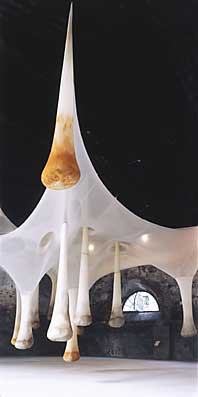 An exhibition of the work of Brazilian artist, Ernesto Neto, presents a sensual experience. Engorged fabric sculptures stretch across exhibition spaces resembling both architectural forms and bodily membranes. Neto uses materials that engage all the senses; smell and touch are as important as sight. An exhibition of the work of Brazilian artist, Ernesto Neto, presents a sensual experience. Engorged fabric sculptures stretch across exhibition spaces resembling both architectural forms and bodily membranes. Neto uses materials that engage all the senses; smell and touch are as important as sight.
Neto often uses a stretch material, like lycra, that is held taut and weighted with aromatic spices such as turmeric and clove or other materials including graphite or lead shot. He attaches stocking-shaped forms to the ceiling and throws them to the ground, creating a corona of colourful powder on the floor. The colour of the substances against the milky-whiteness of the fabric and gallery space is visually engaging and the rich and spicy smell announces the work before it is seen.
He also creates semi-transparent rooms, soft cubes that recall skin-like membranes. The viewer enters these rooms and quite literally has to engage with the work, pushing and pulling and altering its semi-transparent shape through walking through the space. The fabric feels like a soft and giving skin and Neto enhances this association by embroidering orifices into the membrane. These works are the opposite of the �don�t touch� dictum that usually rules in art galleries, as they desire a physical relationship with their audience.
Neto considers that this can be ��. a place of sensations, a place of exchange and continuity between people, a skin of existence and relationships�.
In July Ernesto Neto will undertake a residency at the School of Fine Arts at the University of Newcastle. During this time he will make a new room installation for the Contemporary Projects Space at the Art Gallery of New South Wales that will be on display from 26 July to 8 September 2002.
Ernesto Neto lives and works in Rio de Janeiro, Brazil. He is amongst a group of younger Brazilian artists who have come to international prominence over the last decade. He has had numerous exhibitions including solo shows at the Kunsthalle Basel, the Kiasmia Museum of Contemporary Art, Helsinki, and the ICA in London. He was also included in the 2001 Venice Biennale, in Space-Jack at the Yokohama Art Museum, in Trace, the inaugural Liverpool Biennial 1999 and in the 1998 Sao Paulo Biennial and in Loose Threads at the Serpentine Gallery, London. Neto�s work was last seen at the Art Gallery of New South Wales in the 1997 Guinness exhibition, Material/Immaterial.
|